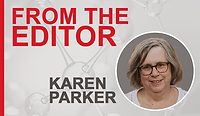Editor’s Memo
Leaving on a High Note for the Adhesives Industry
Over the past 10 years, writing this column has always been one of the most difficult parts of my job. It’s even more difficult this month since I am stepping down from ASI to devote more time to my family.
I want to thank all of you who have helped make ASI a success. I especially want to acknowledge the many authors and contributors to articles; the advisory board; the adhesives organizations, including the Adhesive and Sealant Council, Pressure Sensitive Tape Council, Adhesion Society and TAPPI’s Hot Melt Section (now part of PLACE); and the great staff here at Business News Publishing Co., including Kristin Johansson, our managing editor. Most of all, I want to thank you, the readers and advertisers of ASI, for your support.
It’s reassuring to leave ASI in the capable hands of Teresa McPherson, your new editor, who takes over with six years of editorial experience on our sister publication, Paint & Coatings Industry magazine (PCI). I encourage you to contact Teresa with any of your future editorial needs. She can be reached at 810-664-0030, mcphersont@bnp.com. It is also reassuring to leave seeing positive predictions for our industry, such as this one from a new study on specialty adhesives from The Freedonia Group, Inc., a Cleveland-based industrial market research firm.
According to the study, the demand for specialty adhesives in the United States is forecast to increase 6.7 percent per year, from a relatively weak 2002 base to $3 billion in 2007, with market volume forecast to rise four percent per year to 780 million pounds. Advances will benefit from a solid outlook in key end uses for durable goods, particularly electronic components, medical products and aerospace equipment. In terms of product mix, cyanoacrylates will achieve the most rapid gains, particularly due to expanding applications in both medical products and on-site construction.
While specialty adhesives represent only about four percent of volume demand for the U.S. adhesives industry, they snag about one-quarter of the total dollar value based on their higher prices.
In 2002, the manufacturing and assembly market accounted for 80 percent of the total demand for specialty adhesives. The fact that specialty adhesives can augment or eliminate requirements for mechanical fasteners in structural applications will promote growth in various manufacturing and assembly markets, such as electronic components, motor vehicles and aerospace equipment.
The study goes on to say that the use of specialty adhesives in the on-site construction market will be promoted by an acceleration in non-residential building activity. Residential building projects will also provide opportunities for specialty adhesives, primarily due to architectural trends favoring greater adhesive usage in structural applications, where specialty adhesives are being increasingly used to augment or replace traditional mechanical fasteners.
The Adhesive and Sealant Council is right on-target with its recently initiated Building the Industry (BTI) program. BTI will help members understand how to replace incumbent fasteners in broad segments where structural adhesives and sealants can be used.
Specialty Adhesives (published April 2003, 222 pages) is available for $3,800 from The Freedonia Group, Inc., 767 Beta Dr., Cleveland, OH 44143-2326. For further details, contact Corinne Gangloff by phone 440-684-9600, fax 440-646-0484 or e-mail pr@freedoniagroup.com; or visit the Web site http://www.freedoniagroup.com.
For more information:
For more information on BTI, see this magazine, Feb. 2003, pp. 19-20, or visit the ASC Web site http://www.ascouncil.org.Looking for a reprint of this article?
From high-res PDFs to custom plaques, order your copy today!






